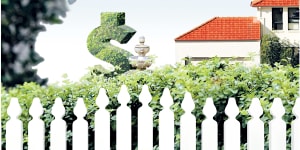Australian Bureau of Statistics data initially showed a dearth of new loans for investment properties in 2020,before lending values in the past 12 months almost doubled.

Fixed interest rates – often the preference for property investors wanting cost certainty – are on the rise.Suzanne White
The number of new loans for investment properties from last October to the same month this year jumped from 11,645 to 18,587.
An over-heated property market and unsustainable frenzy? Investors don’t think so,essentially squeezing out many first homebuyers.
Fixed interest rates – often the preference for property investors wanting cost certainty – are on the rise. Last week,NAB became the last of the big-four banks to cease offering a fixed interest rate of less than 2 per cent

However,there are still some attractive interest rates available if you want to buy – or refinance – an investment property.Money asked Mozo to identify some of the best.
Starting with variable rates, Queensland Country Bank still has a sub-2 per cent offering – 1.99 per cent. ThenReduce Home Loans charges 2.09 per cent,homeloans.com.au 2.14 per cent,andTic:Toc andYard,both 2.19 per cent.
Note that these rates are all for principal-and-interest repayments,as there has been a clampdown by the Australian Prudential Regulation Authority on interest-only mortgages.
If you can obtain an interest-only loan,it likely carries a higher interest rate.
Many investors looking for certainty of repayments and a predictable tax situation favour fixed interest rates. Here,over one year,Greater Bank leads the interest rates charge,with 1.89 per cent. Then comesDefence Bank andRACQ Bank,both with 1.99 per cent,andPolice Credit Union with 2.09 per cent.
Over three years,the top players look a little different.
The sharpest three-year fixed rate comes fromMOVE Bank,at 1.99 per cent.Australian Mutual Bank is offering 2.23 per cent,Easy Street has 2.29 per cent,andBankwest andWell Home Loans tie for fourth place with 2.34 per cent.
What you will notice about almost all the fixed rates in the accompanying tables is that the comparison interest rate – the rate the loan defaults to after the fixed-rate period – can be significantly higher. In part,that is because the lender may be using the fixed rate to lure you into its mortgage product.
The comparison rate calculates the true cost of a loan – including all interest and fees – over a 25-year period. However,it is based on borrowing $150,000,which is so low that it disproportionately emphasises fees.
If you think about it,after a three-year fixed rate,there are another 22 years of variable rates captured in the comparison rate calculation,so most of the comparison rate for fixed loans is driven by whatever rate is being used on the day the mortgage reverts to a variable rate loan.
Peter Marshall,head of research at Mozo,says savvy investors need not just cop the higher variable rate at the end of the fixed rate period.
“In many cases,lenders will work with you at the end of the fixed period to transfer the loan to a more appropriate rate – the comparison rate is just the ‘if-you-do-nothing-to-change-it’ rate,” he says. That makes it essential that you know when your fixed rate period ends,so you can ensure you do not get railroaded into an uncompetitive variable interest rate.
With fixed rates on the increase across both owner-occupier and investor mortgages,anyone looking to lock in has little time to delay.
Nicole Pedersen-McKinnon is the author of. Follow Nicole on, or.